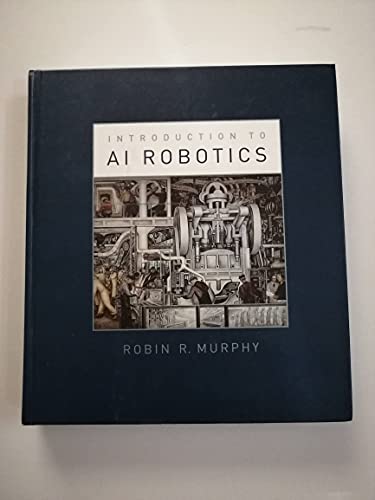arkin ronald c (19 Ergebnisse)
FeedbackSuchfilter
Produktart
- Alle Product Types
- Bücher (19)
- Magazine & Zeitschriften (Keine weiteren Ergebnisse entsprechen dieser Verfeinerung)
- Comics (Keine weiteren Ergebnisse entsprechen dieser Verfeinerung)
- Noten (Keine weiteren Ergebnisse entsprechen dieser Verfeinerung)
- Kunst, Grafik & Poster (Keine weiteren Ergebnisse entsprechen dieser Verfeinerung)
- Fotografien (Keine weiteren Ergebnisse entsprechen dieser Verfeinerung)
- Karten (Keine weiteren Ergebnisse entsprechen dieser Verfeinerung)
- Manuskripte & Papierantiquitäten (Keine weiteren Ergebnisse entsprechen dieser Verfeinerung)
Zustand Mehr dazu
- Neu (9)
- Wie Neu, Sehr Gut oder Gut Bis Sehr Gut (Keine weiteren Ergebnisse entsprechen dieser Verfeinerung)
- Gut oder Befriedigend (10)
- Ausreichend oder Schlecht (Keine weiteren Ergebnisse entsprechen dieser Verfeinerung)
- Wie beschrieben (Keine weiteren Ergebnisse entsprechen dieser Verfeinerung)
Einband
Weitere Eigenschaften
- Erstausgabe (Keine weiteren Ergebnisse entsprechen dieser Verfeinerung)
- Signiert (Keine weiteren Ergebnisse entsprechen dieser Verfeinerung)
- Schutzumschlag (1)
- Angebotsfoto (4)
Sprache (1)
Gratisversand
Land des Verkäufers
Verkäuferbewertung
-
Behavior-Based Robotics (Intelligent Robotics and Autonomous Agents)
Verlag: Bradford Books (edition Third Printing, 2000), 1998
ISBN 10: 0262011654 ISBN 13: 9780262011655
Sprache: Englisch
Anbieter: BooksRun, Philadelphia, PA, USA
EUR 5,65
Währung umrechnenEUR 6,81 für den Versand von USA nach DeutschlandAnzahl: 1 verfügbar
In den WarenkorbHardcover. Zustand: Good. Third Printing, 2000. It's a preowned item in good condition and includes all the pages. It may have some general signs of wear and tear, such as markings, highlighting, slight damage to the cover, minimal wear to the binding, etc., but they will not affect the overall reading experience.
-
The Robotics Primer (OIP) (Intelligent Robotics and Autonomous Agents series)
Anbieter: WorldofBooks, Goring-By-Sea, WS, Vereinigtes Königreich
EUR 11,50
Währung umrechnenEUR 4,02 für den Versand von Vereinigtes Königreich nach DeutschlandAnzahl: 1 verfügbar
In den WarenkorbPaperback. Zustand: Very Good. The book has been read, but is in excellent condition. Pages are intact and not marred by notes or highlighting. The spine remains undamaged.
-
EUR 6,50
Währung umrechnenEUR 10,96 für den Versand von USA nach DeutschlandAnzahl: 1 verfügbar
In den WarenkorbZustand: Good. Used book that is in clean, average condition without any missing pages.
-
EUR 6,50
Währung umrechnenEUR 10,96 für den Versand von USA nach DeutschlandAnzahl: 2 verfügbar
In den WarenkorbZustand: Good. Used book that is in clean, average condition without any missing pages.
-
EUR 10,62
Währung umrechnenEUR 8,27 für den Versand von USA nach DeutschlandAnzahl: 1 verfügbar
In den WarenkorbZustand: Good. Used book that is in clean, average condition without any missing pages.
-
EUR 7,67
Währung umrechnenEUR 11,31 für den Versand von USA nach DeutschlandAnzahl: 1 verfügbar
In den WarenkorbZustand: Good. Used book that is in clean, average condition without any missing pages.
-
BehaviorBased Robotics (Intelligent Robots and Autonomous Agents) [Hardcover] Arkin, Ronald
Anbieter: Hay-on-Wye Booksellers, Hay-on-Wye, HEREF, Vereinigtes Königreich
EUR 21,42
Währung umrechnenEUR 9,76 für den Versand von Vereinigtes Königreich nach DeutschlandAnzahl: 1 verfügbar
In den WarenkorbZustand: Good. Dust jacket has light scratches/marks and outer edges have minor scuffs. Content is in like new condition.
-
Behavior-Based Robotics (Intelligent Robots and Autonomous Agents).
Anbieter: Antiquariat Thomas Nonnenmacher, Freiburg, Deutschland
EUR 30,00
Währung umrechnenEUR 4,00 für den Versand innerhalb von/der DeutschlandAnzahl: 1 verfügbar
In den WarenkorbLeinen. Zustand: Gut. XIV, 490 Seiten. Minimale Lesespuren. Ansonsten sehr gut erhalten. 9780262011655 Sprache: Englisch Gewicht in Gramm: 2400.
-
Evolutionary Robotics : The Biology, Intelligence, and Technology of Self-Organizing Machines
Anbieter: Better World Books, Mishawaka, IN, USA
EUR 38,43
Währung umrechnenEUR 8,25 für den Versand von USA nach DeutschlandAnzahl: 1 verfügbar
In den WarenkorbZustand: Very Good. Used book that is in excellent condition. May show signs of wear or have minor defects.
-
Behavior-Based Robotics (Intelligent Robotics and Autonomous Agents series)
Anbieter: Ria Christie Collections, Uxbridge, Vereinigtes Königreich
EUR 78,25
Währung umrechnenEUR 5,72 für den Versand von Vereinigtes Königreich nach DeutschlandAnzahl: Mehr als 20 verfügbar
In den WarenkorbZustand: New. In.
-
EUR 112,07
Währung umrechnenEUR 11,49 für den Versand von Vereinigtes Königreich nach DeutschlandAnzahl: 2 verfügbar
In den WarenkorbPaperback. Zustand: Brand New. reprint edition. 506 pages. 9.00x7.00x1.40 inches. In Stock.
-
EUR 122,22
Währung umrechnenEUR 4,51 für den Versand von Vereinigtes Königreich nach DeutschlandAnzahl: 1 verfügbar
In den WarenkorbZustand: Good. Your purchase helps support Sri Lankan Children's Charity 'The Rainbow Centre'. Ex-library, so some stamps and wear, but in good overall condition. Our donations to The Rainbow Centre have helped provide an education and a safe haven to hundreds of children who live in appalling conditions.
-
EUR 130,91
Währung umrechnenEUR 11,49 für den Versand von Vereinigtes Königreich nach DeutschlandAnzahl: 1 verfügbar
In den WarenkorbHardcover. Zustand: Brand New. 2nd edition. 620 pages. 9.25x8.25x1.50 inches. In Stock.
-
Robot Colonies
Verlag: Springer US, Springer US Dez 2010, 2010
ISBN 10: 144195175X ISBN 13: 9781441951755
Sprache: Englisch
Anbieter: buchversandmimpf2000, Emtmannsberg, BAYE, Deutschland
EUR 160,49
Währung umrechnenKostenlos für den Versand innerhalb von/der DeutschlandAnzahl: 2 verfügbar
In den WarenkorbTaschenbuch. Zustand: Neu. Neuware -Robots in groups or colonies can exhibit an enormous variety and richness of behaviors which cannot be observed with singly autonomous systems. Of course, this is analogous to the amazing variety of group animal behaviors which can be observed in nature. In recent years more and more investigators have started to study these behaviors. The studies range from classifications and taxonomies of behaviors, to development of architectures which cause such group activities as flocking or swarming, and from emphasis on the role of intelligent agents in such groups to studies of learning and obstacle avoidance. There used to be a time when many robotics researchers would question those who were interested in working with teams of robots: `Why are you worried about robotic teams when it's hard enough to just get one to work '. This issue responds to that question. Robot Colonies provides a new approach to task problem-solving that is similar in many ways to distributed computing. Multiagent robotic teams offer the possibility of spatially distributed parallel and concurrent perception and action. A paradigm shift results when using multiple robots, providing a different perspective on how to carry out complex tasks. New issues such as interagent communications, spatial task distribution, heterogeneous or homogeneous societies, and interference management are now central to achieving coordinated and productive activity within a colony. Fortunately mobile robot hardware has evolved sufficiently in terms of both cost and robustness to enable these issues to be studied on actual robots and not merely in simulation. Robot Colonies presents a sampling of the research in this field. While capturing a reasonable representation of the most important work within this area, its objective is not to be a comprehensive survey, but rather to stimulate new research by exposing readers to the principles of robot group behaviors, architectures and theories. Robot Colonies is an edited volume of peer-reviewed original research comprising eight invited contributions by leading researchers. This research work has also been published as a special issue of Autonomous Robots (Volume 4, Number 1).Springer Verlag GmbH, Tiergartenstr. 17, 69121 Heidelberg 160 pp. Englisch.
-
EUR 162,91
Währung umrechnenKostenlos für den Versand innerhalb von/der DeutschlandAnzahl: 1 verfügbar
In den WarenkorbTaschenbuch. Zustand: Neu. Druck auf Anfrage Neuware - Printed after ordering - Robots in groups or colonies can exhibit an enormous variety and richness of behaviors which cannot be observed with singly autonomous systems. Of course, this is analogous to the amazing variety of group animal behaviors which can be observed in nature. In recent years more and more investigators have started to study these behaviors. The studies range from classifications and taxonomies of behaviors, to development of architectures which cause such group activities as flocking or swarming, and from emphasis on the role of intelligent agents in such groups to studies of learning and obstacle avoidance. There used to be a time when many robotics researchers would question those who were interested in working with teams of robots: `Why are you worried about robotic teams when it's hard enough to just get one to work '. This issue responds to that question. Robot Colonies provides a new approach to task problem-solving that is similar in many ways to distributed computing. Multiagent robotic teams offer the possibility of spatially distributed parallel and concurrent perception and action. A paradigm shift results when using multiple robots, providing a different perspective on how to carry out complex tasks. New issues such as interagent communications, spatial task distribution, heterogeneous or homogeneous societies, and interference management are now central to achieving coordinated and productive activity within a colony. Fortunately mobile robot hardware has evolved sufficiently in terms of both cost and robustness to enable these issues to be studied on actual robots and not merely in simulation. Robot Colonies presents a sampling of the research in this field. While capturing a reasonable representation of the most important work within this area, its objective is not to be a comprehensive survey, but rather to stimulate new research by exposing readers to the principles of robot group behaviors, architectures and theories. Robot Colonies is an edited volume of peer-reviewed original research comprising eight invited contributions by leading researchers. This research work has also been published as a special issue of Autonomous Robots (Volume 4, Number 1).
-
EUR 164,73
Währung umrechnenEUR 5,72 für den Versand von Vereinigtes Königreich nach DeutschlandAnzahl: Mehr als 20 verfügbar
In den WarenkorbZustand: New. In.
-
EUR 168,73
Währung umrechnenKostenlos für den Versand innerhalb von/der DeutschlandAnzahl: 1 verfügbar
In den WarenkorbBuch. Zustand: Neu. Druck auf Anfrage Neuware - Printed after ordering - Robots in groups or colonies can exhibit an enormous variety and richness of behaviors which cannot be observed with singly autonomous systems. Of course, this is analogous to the amazing variety of group animal behaviors which can be observed in nature. In recent years more and more investigators have started to study these behaviors. The studies range from classifications and taxonomies of behaviors, to development of architectures which cause such group activities as flocking or swarming, and from emphasis on the role of intelligent agents in such groups to studies of learning and obstacle avoidance. There used to be a time when many robotics researchers would question those who were interested in working with teams of robots: `Why are you worried about robotic teams when it's hard enough to just get one to work '. This issue responds to that question. Robot Colonies provides a new approach to task problem-solving that is similar in many ways to distributed computing. Multiagent robotic teams offer the possibility of spatially distributed parallel and concurrent perception and action. A paradigm shift results when using multiple robots, providing a different perspective on how to carry out complex tasks. New issues such as interagent communications, spatial task distribution, heterogeneous or homogeneous societies, and interference management are now central to achieving coordinated and productive activity within a colony. Fortunately mobile robot hardware has evolved sufficiently in terms of both cost and robustness to enable these issues to be studied on actual robots and not merely in simulation. Robot Colonies presents a sampling of the research in this field. While capturing a reasonable representation of the most important work within this area, its objective is not to be a comprehensive survey, but rather to stimulate new research by exposing readers to the principles of robot group behaviors, architectures and theories. Robot Colonies is an edited volume of peer-reviewed original research comprising eight invited contributions by leading researchers. This research work has also been published as a special issue of Autonomous Robots (Volume 4, Number 1).
-
EUR 231,69
Währung umrechnenEUR 11,49 für den Versand von Vereinigtes Königreich nach DeutschlandAnzahl: 2 verfügbar
In den WarenkorbHardcover. Zustand: Brand New. reprint edition. 153 pages. 10.75x8.00x0.50 inches. In Stock.
-
EUR 243,57
Währung umrechnenEUR 1,87 für den Versand von USA nach DeutschlandAnzahl: 15 verfügbar
In den WarenkorbZustand: New. 1997. Hardcover. . . . . . Books ship from the US and Ireland.













